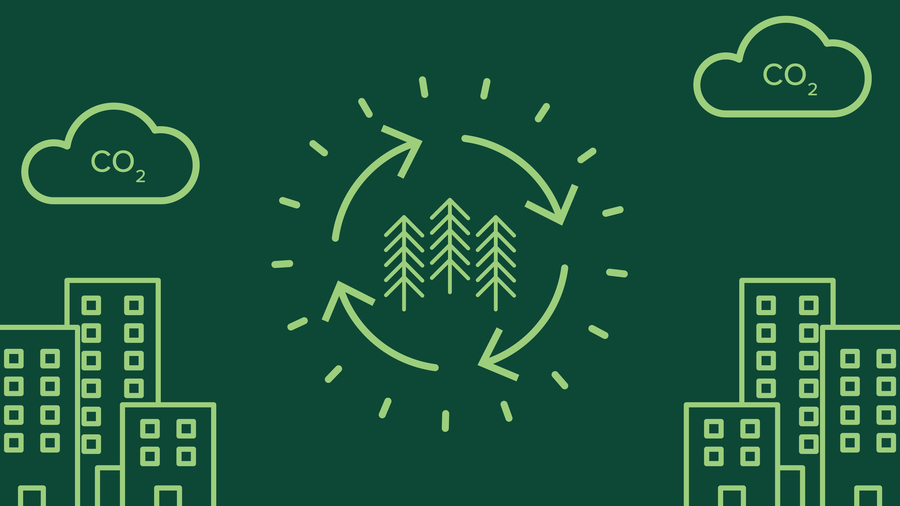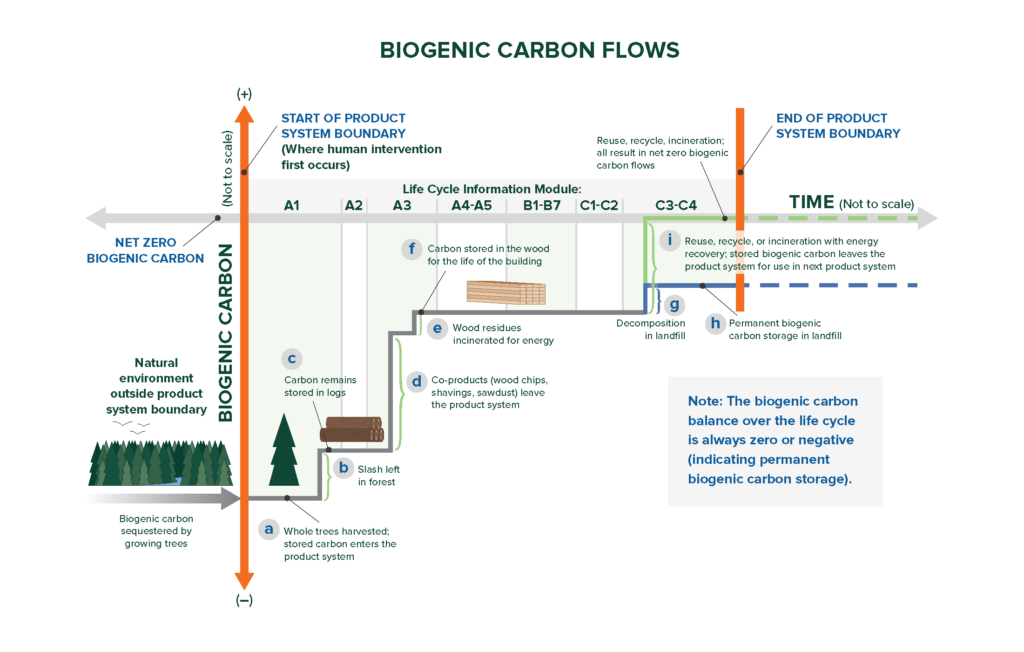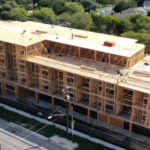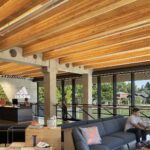Expert Tips
How to Include Biogenic Carbon in an LCA
Part 2 in a series on biogenic carbon accounting for wood products – specifics for each stage of the life cycle

Biogenic carbon in wood products refers to carbon sequestered by a tree during its growth that continues to be stored in wood products over their lifetime. For an introduction to this topic, start with Part 1. Recall that when biogenic carbon enters the product system, it is reported as a negative value (carbon removal); when biogenic carbon leaves the product system, it is reported as a positive value (carbon emission or export). But what does this mean in practice as we look at each stage of the life cycle? (Life cycle stages are outlined in this expert tip.)
Here, we’ll walk through the specifics of biogenic carbon accounting at each stage of a wood product’s life cycle. This is depicted in Figure 1 and described in more detail in the sections to follow. Keep in mind that there will also be fossil carbon emissions and other flows like freshwater consumption and waste output. Biogenic carbon flows should be reported for the life cycle stage in which they occur and are tracked separately from fossil carbon.

Figure 1. Biogenic Carbon Flows for Wood Products per ISO 21930
Click here to view a larger version of this image
Production Stage: Modules A1-A3
Life cycle assessments (LCAs) have a defined system boundary that allows us to consistently measure inputs to and outputs from that system. In the context of this article, our product system is a wood product—such as a 2×4, an engineered wood beam, or a mass timber floor panel—that will be used as a structural building material. The life cycle of these wood products begins at the first point of human intervention into the forest. Prior to that, trees grow and sequester carbon from the atmosphere in the natural environment. Trees will also undergo other processes within the natural environment, such as respiration and absorption of rain- and groundwater, and they might succumb to fire or disease. As depicted in Figure 1, all these things that occur in the natural environment are outside the product system boundary and are not part of the LCA of a wood product. However, when human activities occur, they are accounted for in the wood product’s LCA, as described below.
Module A1 is extraction and upstream production and includes all forest management operations starting at the first point of human intervention1—from building roads, any fertilization and precommercial thinning that occurs, and final harvest operations, through to growing seedlings and replanting the next generation of trees. Biogenic carbon enters the product system in Module A1 as a negative value equal to the total amount of carbon stored in the trunk, branches and leaves of the tree; see point a in Figure 1. The biogenic carbon stored in the branches and leaves will immediately leave the system in the form of slash and is counted as a positive value; see point b in Figure 1. Therefore, the value reported in A1 is a net negative value equal to the total amount of carbon stored in the logs when they are ready to leave the forest; see point c in Figure 1.
Module A2 is transportation of the logs from the forest to the mill. There are no biogenic carbon flows associated with this module.
Module A3 includes all processing that occurs at the log yard and sawmill. During this stage, the round logs are debarked, sawn into rectangular shapes, dried, planed to their final size, and packaged for distribution. Throughout this process, about half of a log’s volume is converted to co-product,2 such as wood chips, sawdust, shavings and bark. These co-products leave the product system and are often used as inputs for the manufacturing of other wood-based products. When this happens, the biogenic carbon stored in the co-products is accounted for as a positive value; see point d in Figure 1.
Additional wood residues are often recovered for electricity and heat at the mill, and typically used to heat the drying kilns, reducing the consumption of fossil fuels that may be entering a mill through the power grid. When wood residues are combusted, this biogenic carbon also leaves the system boundary and is quantified as a positive value; see point e in Figure 1.
At the conclusion of A3, the biogenic carbon reported is net negative and equal to the amount of biogenic carbon stored in the finished wood product when it is ready to leave the mill; see point f in Figure 1.
Production Stage: Modules A1-A3 for Engineered Wood Products
For engineered wood products that undergo manufacturing processes beyond the mill, there will be an additional Module A2 process, representing transportation of the lumber from the mill to the manufacturer. Again, there are no biogenic carbon flows associated with this step.
There will be additional manufacturing inputs for Module A3 to account for sorting, gluing (and all A1-A3 inputs and outputs associated with any adhesives/resins), planing, and packaging the engineered wood products. There will also be biogenic carbon flows out of the system to account for material that leaves the system through the process of planing/cutting.
A note about biogenic carbon accounting in North American wood EPDs:
Note that when this information is reported in a cradle-to-gate (Modules A1-A3) EPD or LCA, the product category rules (PCR) that govern North American wood products require that the stored biogenic carbon be completely released in the end-of-life modules (C3-C4) so that cradle-to-gate biogenic carbon flows are reported as net-zero (i.e., no net removals). This may be conservative depending on actual end-of-life scenarios such as landfilling, which can result in permanent biogenic carbon storage, or reuse and recycling where biogenic carbon is transferred to the next product system where it continues to be stored. While North American cradle-to-gate EPDs are required to report net-zero biogenic carbon, it is possible to quantify and report net negative biogenic carbon flows within a WBLCA.
Construction Stage: Modules A4-A5
Module A4 is transportation of the wood product from the mill or manufacturer to the construction site. Like Module A2, there are no biogenic carbon flows associated with this module.
Module A5 is the installation of the product itself. When wood products leave the building site as construction waste, the biogenic carbon stored in those products will be counted as a positive value. Note that prefabricated systems are less likely to generate on-site waste.
Use Stage: Modules B1-B7
Module B is the use of the building over its service life. There may be biogenic carbon flows into or out of the system in module B4 representing materials that are removed and replaced over the building’s life. Structural wood products are intended to have a lifespan equivalent to that of the building (typically 60-100 years). Therefore, there are typically no biogenic carbon flows associated with this life cycle stage.
A note about WBLCA tools:
Materials’ default lifespans are assigned within WBLCA tools. As a tool user, it is important to review the default for each material to ensure accuracy as this can have a drastic effect on the results. In Tally, the default service life can be adjusted by the user. Some structural wood products default to the life of the building while others default to 60 years or less. Notably, domestic softwood lumber defaults to 30 years. Because structural materials are generally designed to last for the life of the building, users should manually adjust the material lifespans to be equal to the building life.3
End-of-Life Stage: Modules C1-C4
The life cycle of a structural wood product used in a building typically ends when the building itself is deconstructed or demolished—this marks the end of our product system boundary. At the end of a building’s life, wood products generally have four possible end-of-life fates: landfill, incineration for energy recovery, recycling, or reuse. For a WBLCA, these biogenic carbon flows are reported in Modules C3/C4.
Landfill – In landfills, a significant portion of the biogenic carbon can be stored permanently (more than 100 years), while some biogenic carbon dioxide and biogenic methane emissions are released as landfill gases; see point g in Figure 1. The portion of biogenic carbon that is permanently stored does not leave the product system (i.e., it is not emitted back to the atmosphere); see point h in Figure 1. Landfill gases can be released directly to the atmosphere but are often captured for energy recovery. In all cases, any biogenic carbon released from a landfill is accounted for as an emission. Biogenic methane emissions are also quantified but are reported separately from the biogenic carbon inventory discussed here.
Incineration for Energy recovery – When wood products are recovered for energy, all the biogenic carbon that was stored in the combusted material is released directly back into the atmosphere and is reported as a positive value in Modules C3/C4; see point i in Figure 1.
Recycling – Module C3 covers waste processing. When a wood product is recycled at the end of a building’s service life, any transportation and processing required for its next use is accounted for in Modules C2 and C3, respectively. The processing itself is typically performed by equipment powered by fossil fuels and/or electricity and therefore does not involve any biogenic carbon flows. However, once the material is processed, it leaves the system boundary for use in a future product system, similar to co-products that left the system during Module A3. Therefore, when a product is recycled, all biogenic carbon that was stored in the material is reported as a positive value; see point i in Figure 1.
Reuse – In direct reuse, a wood product leaves the product system for the first building and enters the product system for a second building. When it leaves the first building, all the biogenic carbon that was stored in the material is reported as a positive value, similar to recycling; see point i in Figure 1. However, unlike recycling which often requires the original material to be processed into a new product, direct reuse typically requires little to no additional processing and allows the original product to continue serving its original function within a new system. Any transportation required to deliver the wood product to its next use is accounted for in Module C2.
Conclusion
The biogenic carbon inventory keeps track of the carbon that is stored in the wood at each stage of the life cycle. At the beginning of Module A1, we start with a large negative value representing the uptake of carbon during the life of the tree. Throughout the life cycle, there are positive values attributed to biogenic carbon exports and emissions that chip away at that initial negative value. At the end-of-life, carbon may be permanently stored, or may leave the system through decay, combustion, or products leaving the system boundary. This results in either net negative or net zero biogenic carbon storage over the life cycle of the wood product. As shown in Figure 1, biogenic carbon emissions never exceed biogenic carbon removals, so there is never a net positive emission associated with biogenic carbon flows.
Biogenic carbon should be included in WBLCAs in accordance with ISO 21930 and should include all the flows mentioned in this article. For specifics on how WBLCA tools account for biogenic carbon, see Part 3. For a discussion on the additional benefits of long-term biogenic carbon storage, see Part 4.
Additional Resources:
International Organization for Standardization. (2017). ISO 21930:2017 Sustainability in buildings and civil engineering works – Core rules for environmental product declarations of construction products and services.
Milota, M., Puettmann, M. CORRIM. (2020, March). Life Cycle Assessment for the Production of Pacific Northwest Softwood Lumber.
Milota, M., Puettmann, M. CORRIM. (2020, March). Life Cycle Assessment for the Production of Southeastern Softwood Lumber.
Puettmann, M. CORRIM. (2020, March). Life Cycle Assessment for the Production of Inland Northwest Softwood Lumber.
Puettmann, M. CORRIM. (2020, March). Life Cycle Assessment for the Production of Northeast – Northcentral Softwood Lumber.
Ross, L. American Wood Council. (2021, October). AWC’s LCA, EPDs, GWP, and Other Abbreviations Explained.
Salazar, J. Carbon Leadership Forum. (2020, May). Wood Carbon Seminars: How LCA Handles Wood.
Salazar, J., Miner, R., Oneil, E. Carbon Leadership Forum. (2020, May). Wood Carbon Seminars: Discussion Session 2 (LCA and Wood).
UL Environment. (2020, May). Product Category Rules for Building-Related Products and Services Part B: Structural and Architectural Wood Products EPD Requirements UL 10010-09 v1.1.
1 Human intervention in the form of forest management occurs on working forests or timberlands. These lands are separate from nonworking forests such as our National Parks and designated wilderness areas, which are not managed for timber harvest. For more information on the difference between working and nonworking forests, see NAFO’s Forest Carbon Data Visualization.
2 The North American Softwood Lumber EPD, Table 12
3 Tally Tutorial, “Defining Materials” starting at 0:02:33, https://choosetally.com/tutorials/


